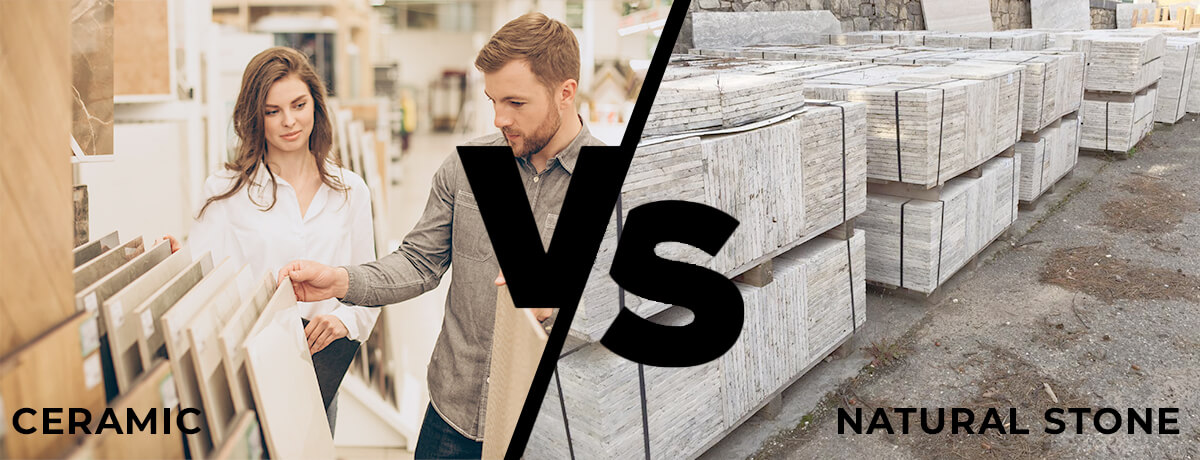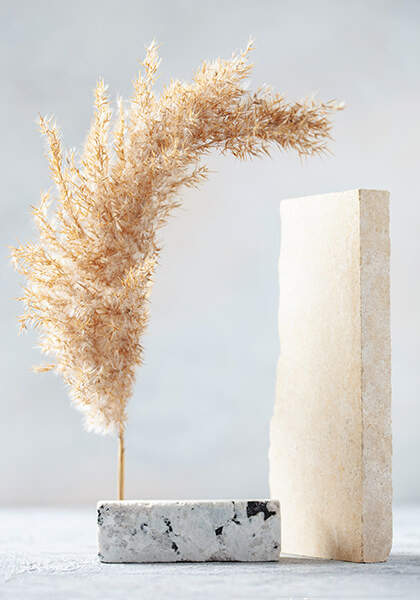Natural Stone vs. Ceramic Tile: What's the Difference and What's Better for Your Project?
3rd Aug 2021

The possibilities for updating and renovating your home are endless. And there comes a moment when you should decide on tiles. And as you begin looking through the different options the market has to offer, the question about what type of tile, natural or ceramic, you should choose for your project naturally comes up.
With the variety of options available, comparing characteristics and durability might be hard and deciding which is better for your space daunting. Understanding the differences between natural stone and ceramic will help you make an informed decision. In this blog post, we will share some useful tips to help you decide which one is better for your project.
What's ceramic tile, and what's natural stone?
Natural stone is as it sounds- straight from Mother Nature, non-man-made. An example of a natural stone is travertine, a type of limestone formed by mineral deposits from natural hot springs over hundreds of thousands of years. Natural stone tiles are synonymous with luxury and elegance, and it naturally increases the resale value of a house, especially if used in a kitchen or a bathroom.
On the other hand, ceramic tiles are man-made, produced from red or white clay hardened in a kiln. Ceramic tiles are available in two forms - unglazed and glazed.
The majority of ceramic tiles are produced with glaze, which creates a good-looking seal over the natural clay. Unglazed tile is rarely ceramic; it's very porous and easily absorbs liquids and stains.

Natural Stone Tile vs. Ceramic - which is better for your project?
When it comes to deciding which material is the perfect fit for your space, it's all about understanding the drawbacks and advantages of both materials. It's also important to think about the overall look of the space you are after and how many people will be using it. Here are some other factors that will help you decide.
1) Appearance
It's hard to mimic the breathtaking look of a natural stone with ceramic man-made tile. Still, thanks to technology, some ceramics can look pretty close to the natural stone.
When it comes to colors, natural stones come in various natural color variations, mainly in different warm, earthy colors palettes. On the other hand, ceramic tiles are manufactured and can come in any color and pattern variations you can imagine. It can even be made to resemble natural stone. Even so, the natural stone tiles have an innate look of luxurious beauty that can never be perfectly replaced.
2) Maintenance
Both natural stone and ceramic tiles require regular maintenance, but the way to do that varies.
When it comes to porosity, mid-range travertine is similar to unglazed ceramic - it should be filled thus creating a smooth impenetrable surface. Most of the natural stones should be sealed to protect against stains from dark or acidic liquids but it depends on the use and high quality travertine can be sealed or left unsealed as its water absorption is minimal in its natural state. For instance, there is no need to seal travertine if you install it in a pool area and with the right finish you also avoid slips and falls.
With glazed ceramic comes ready-to-use, and no sealing is unnecessary. However, terra cotta or unglazed ceramic might need sealant, just like the natural stones would. The ceramic tiles are durable, and you can use a variety of cleaning products. However, if you have a natural stone, you should be more careful and avoid acidic cleaners, as it could damage the stone.
3) Durability
The strength of a ceramic tile comes from the high temperature of the kiln when it's fried. Generally, ceramic tiles come in a variety of hardness ratings. For ultimate durability, you should look for PEI 3 or above. Lower PEI ratings are appropriate for spaces that don't need to endure high foot traffic. Although both natural stone and ceramic are very durable, natural stone like travertine ages well and assumes a warm charm over time whilst ceramic tiles lose their ‘shine’ over time.
As a general rule, natural stone is the more durable material when worked properly. Not to forget that the Coliseum is made of a natural stone - travertine and it's still standing in all it’s majesty.
4) Price
In addition to the cost of the tile, make sure to also factor in the cost of the installation and finishing supplies. You should also consider if the tile will be installed by a professional or it will be a do-it-yourself project. Professional installation is a better option in most cases, but it will also add to your final cost.
Because it's a natural resource, the natural stone usually has a higher price tag than ceramic tile. Ceramic tiles are the preferred option when you are on a budget, as their prices can widely vary based on the finish, style, and grade of the ceramic. Unglazed tiles are less expensive than glazed tiles but require additional finish during the installation.
The bottom line
With so many great variations of natural stone and ceramic tiles, it gets harder to find the style and size that will elevate your space for years to come. When deciding, don't forget to consider your budget and priorities seriously. Is it more important for you to have the warmth of luxurious elegance even if it can be a little more expensive? Or do you prefer the benefits of lookalike ceramic tiles? Do you prefer the timeless look of natural stone like travertine or ceramic fad of the moment?
As natural stone is made from Mother Nature, no two natural stones are alike. Therefore, if you choose a natural stone, you will have a unique, one-of-a-kind masterpiece installed in your space. So, if a natural stone is your choice, you can browse our collection of travertine here.

